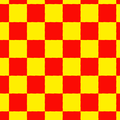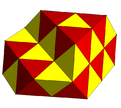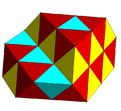Alternated hypercubic honeycomb
Appearance
(Redirected from Alternated hypercube honeycomb)
 An alternated square tiling or checkerboard pattern. |
 An expanded square tiling. |
 A partially filled alternated cubic honeycomb with tetrahedral and octahedral cells. |
 A subsymmetry colored alternated cubic honeycomb. |
In geometry, the alternated hypercube honeycomb (or demicubic honeycomb) is a dimensional infinite series of honeycombs, based on the hypercube honeycomb with an alternation operation. It is given a Schläfli symbol h{4,3...3,4} representing the regular form with half the vertices removed and containing the symmetry of Coxeter group for n ≥ 4. A lower symmetry form can be created by removing another mirror on an order-4 peak.[1]
The alternated hypercube facets become demihypercubes, and the deleted vertices create new orthoplex facets. The vertex figure for honeycombs of this family are rectified orthoplexes.
These are also named as h
| h |
Name | Schläfli symbol |
Symmetry family | ||
|---|---|---|---|---|---|
[4,3n-4,31,1] |
[31,1,3n-5,31,1] | ||||
| Coxeter-Dynkin diagrams by family | |||||
| h |
Apeirogon | {∞} | |||
| h |
Alternated square tiling (Same as {4,4}) |
h{4,4}=t1{4,4} t0,2{4,4} |
|||
| h |
Alternated cubic honeycomb | h{4,3,4} {31,1,4} |
|||
| h |
16-cell tetracomb (Same as {3,3,4,3}) |
h{4,32,4} {31,1,3,4} {31,1,1,1} |
|||
| h |
5-demicube honeycomb | h{4,33,4} {31,1,32,4} {31,1,3,31,1} |
|||
| h |
6-demicube honeycomb | h{4,34,4} {31,1,33,4} {31,1,32,31,1} |
|||
| h |
7-demicube honeycomb | h{4,35,4} {31,1,34,4} {31,1,33,31,1} |
|||
| h |
8-demicube honeycomb | h{4,36,4} {31,1,35,4} {31,1,34,31,1} |
|||
| h |
n-demicubic honeycomb | h{4,3n-3,4} {31,1,3n-4,4} {31,1,3n-5,31,1} |
... | ||
References
[edit]- ^ Regular and semi-regular polytopes III, p.318-319
- Coxeter, H.S.M. Regular Polytopes, (3rd edition, 1973), Dover edition, ISBN 0-486-61480-8
- pp. 122–123, 1973. (The lattice of hypercubes
γ n form the cubic honeycombs,δ n+1) - pp. 154–156: Partial truncation or alternation, represented by h prefix: h{4,4}={4,4}; h{4,3,4}={31,1,4}, h{4,3,3,4}={3,3,4,3}
- p. 296, Table II: Regular honeycombs,
δ n+1
- pp. 122–123, 1973. (The lattice of hypercubes
- Kaleidoscopes: Selected Writings of H. S. M. Coxeter, editied by F. Arthur Sherk, Peter McMullen, Anthony C. Thompson, Asia Ivic Weiss, Wiley-Interscience Publication, 1995, ISBN 978-0-471-01003-6 [1]
- (Paper 24) H.S.M. Coxeter, Regular and Semi-Regular Polytopes III, [Math. Zeit. 200 (1988) 3-45]
| Space | Family | / / | ||||
|---|---|---|---|---|---|---|
| E2 | Uniform tiling | 0[3] | h |
q |
Hexagonal | |
| E3 | Uniform convex honeycomb | 0[4] | h |
q |
||
| E4 | Uniform 4-honeycomb | 0[5] | h |
q |
24-cell honeycomb | |
| E5 | Uniform 5-honeycomb | 0[6] | h |
q |
||
| E6 | Uniform 6-honeycomb | 0[7] | h |
q |
222 | |
| E7 | Uniform 7-honeycomb | 0[8] | h |
q |
133 • 331 | |
| E8 | Uniform 8-honeycomb | 0[9] | h |
q |
152 • 251 • 521 | |
| E9 | Uniform 9-honeycomb | 0[10] | h |
q |
||
| E10 | Uniform 10-honeycomb | 0[11] | h |
q |
||
| En-1 | Uniform (n-1)-honeycomb | 0[n] | h |
q |
1k2 • 2k1 • k21 | |







